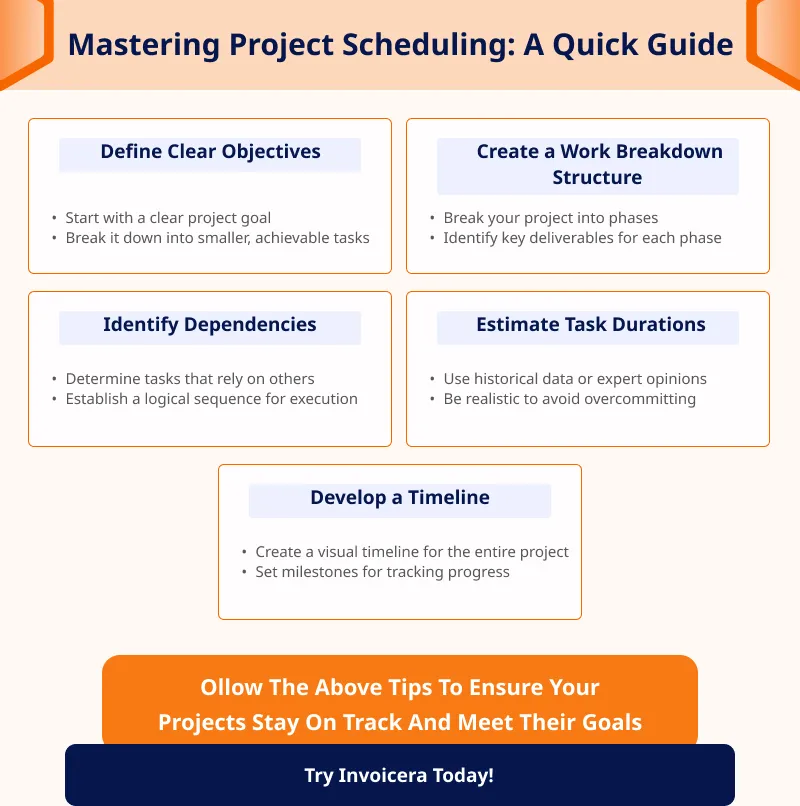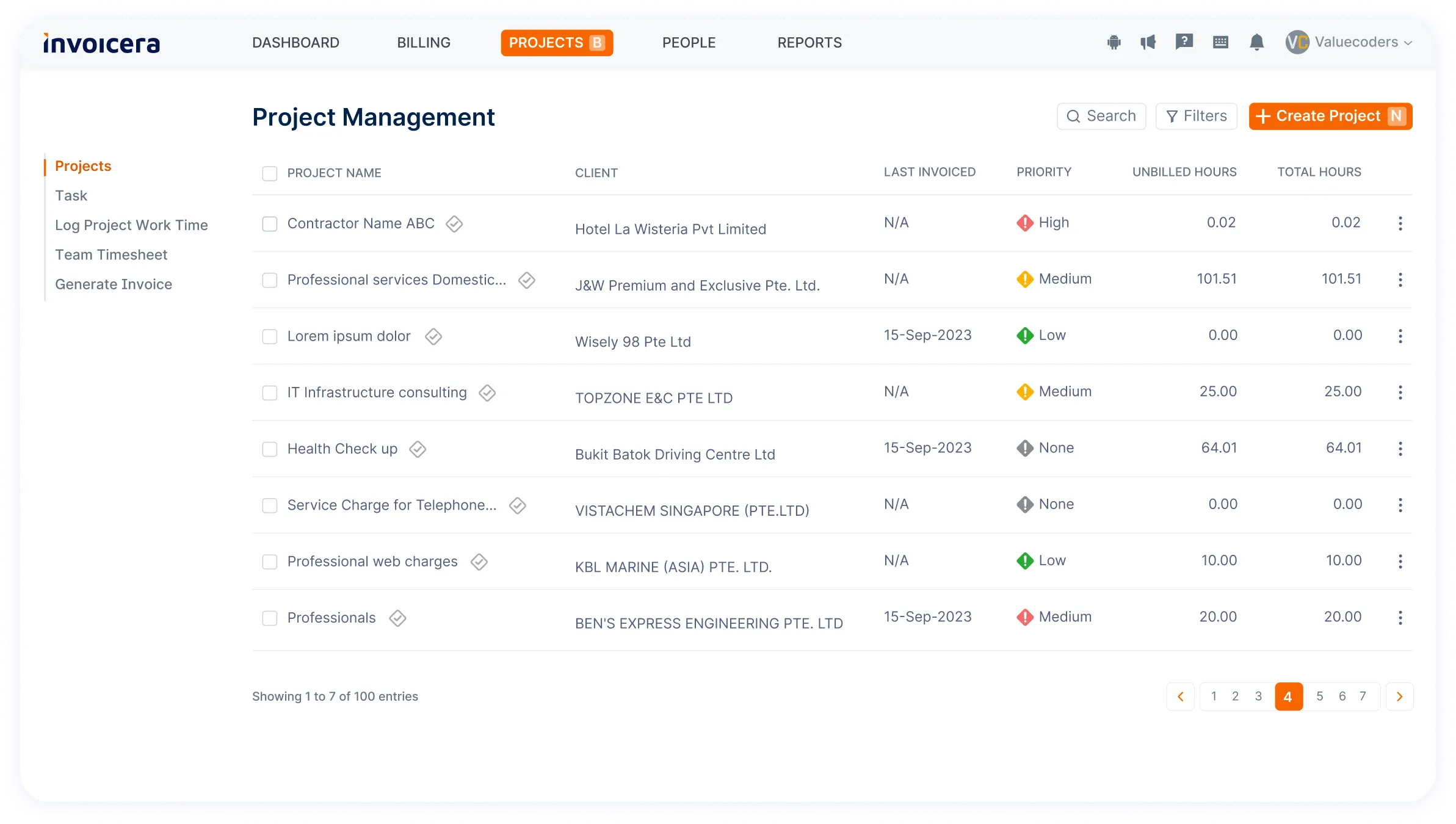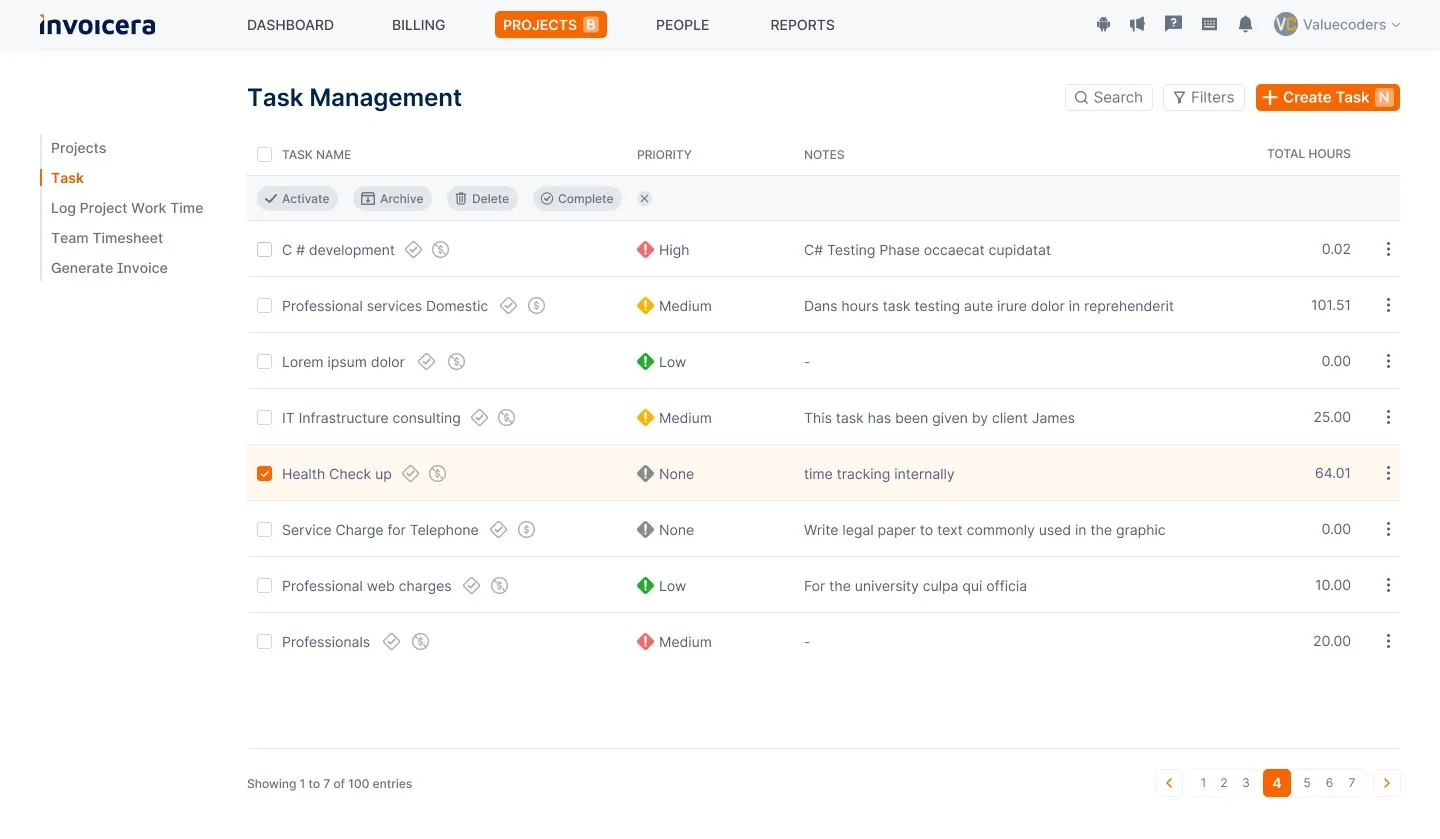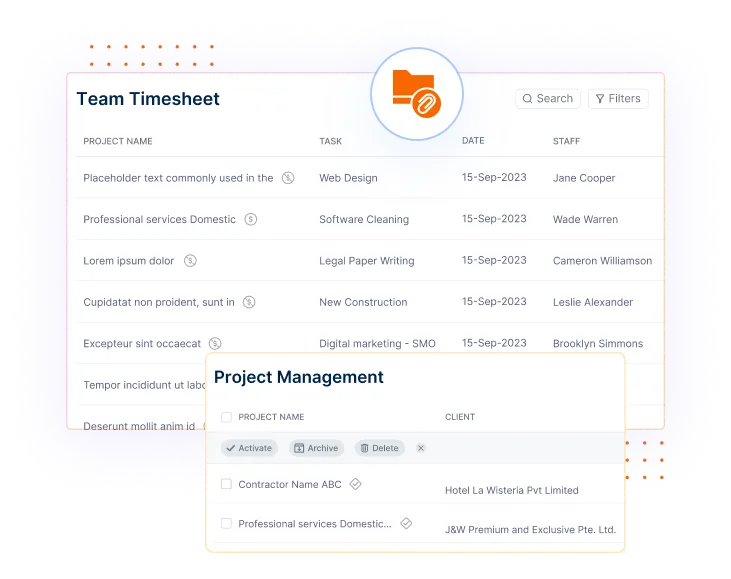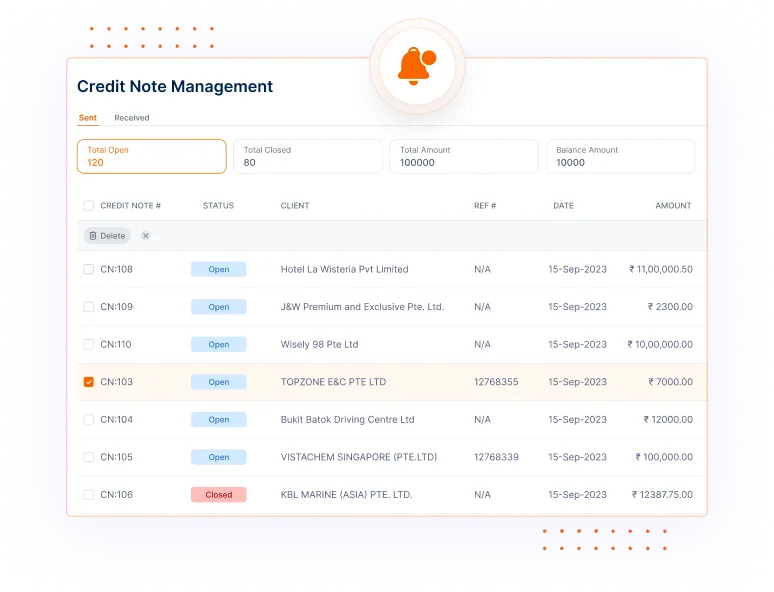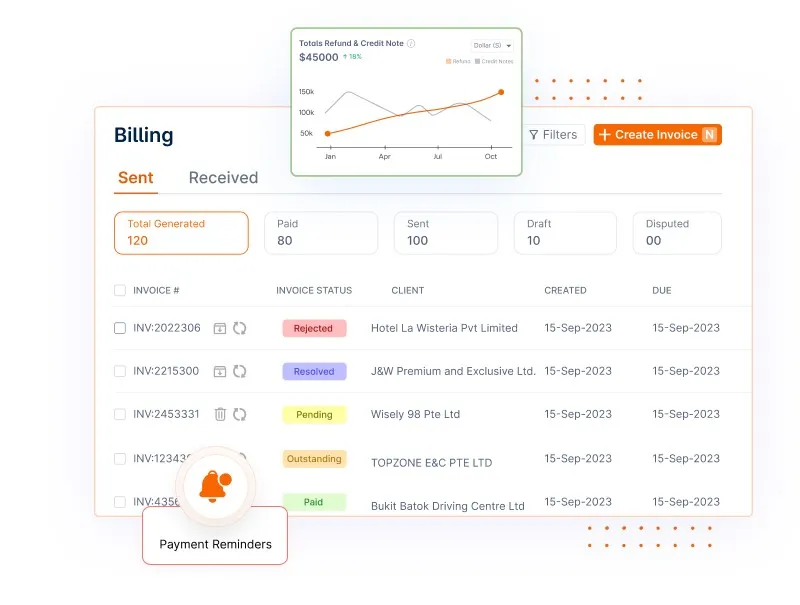When you start a new project, you need to make a plan. As the project manager, you decide how and when to reach the goals. You also figure out all the tasks your team needs to do.
Did You Know?
Companies that consistently complete projects under budget have 65% higher profit margins.
You must put all these parts together correctly and finish on time without spending too much money. That’s a lot to manage before the project even begins.
Once a project starts, tracking how many resources you use is easy. But if time is money, and you can’t see closely how much time was spent, it’s hard to know if the project succeeded. The client will be happy if the job is done well and on time.
But did your business make money or lose money doing it? This is where scheduling the project helps.
With Invoicera’s project tracking, you can accurately bill the client for work completed. The software also generated professional invoices and managed payments, ensuring on-time customer collections.
Read on to learn actionable tips for scheduling your next project in a way that boosts its profit margin.
Summary
A project schedule outlines timeframes and sequences activities to achieve goals efficiently. Scheduling is crucial for profitability. This blog will discuss:
- What Is Project Schedule?
- Key Elements Of Project Scheduling
- Challenges With Project Scheduling
- Benefits Of Project Scheduling
- Tips For Mastering Project Scheduling
- Monitoring Schedules With Invoicera
- Cost-Benefit Analysis Of Scheduling
- Best Practices for Project Schedule Optimization
Solid project scheduling is indispensable for controlling costs, managing risks, and driving profits.
What Is Project Schedule?
A project schedule can be as simple as a to-do list on paper. However, more complex projects or organizations juggling multiple projects need a more advanced way to track progress closely. It’s important to handle schedule conflicts as well to ensure smooth coordination and timely completion of tasks.
Project schedules today need more than wall charts. With teams working remotely from different places and times, software is key. It helps everyone stay on track.
An advanced software has scheduling tools built in. For example, Invoicera lets you make tasks, assign people, and track progress. You can check dashboards to monitor KPIs, team status, project progress, and many more.
A good project schedule includes:
- The policies and processes the team will follow
- Who is involved, and who can approve changes
- All the tasks that need to be done
- The people, tools, time, etc. needed for each task
- When each task starts and finishes
- Which tasks depend on others
To stay on schedule, you need good time estimates for each task. Estimating gets easier if you use data from past, similar projects.
Over time, businesses using project scheduling software will get good data to estimate.
Key Elements Of Project Scheduling
Here are the major key elements of project scheduling:
1. Task Identification and Definition
Identify all the tasks needed to complete the project.
Clearly define what each task involves and what will be delivered. Break big tasks into smaller steps.
2. Sequence of Tasks
Put the tasks in order of what needs to be done first, second, third, etc.
Some tasks depend on others being done first. Build in the right sequence.
3. Estimating Time Requirements
Make an estimate of how long each task will take. Also, include best case, worst case, and most likely time.
Use data from past projects to make realistic estimates.
4. Dependency Analysis
Look at which tasks depend on other tasks.
Link-dependent tasks so you know which can be done in parallel and which must be done sequentially.
5. Resource Allocation
Determine resources like people, equipment, and materials required for each task.
Make sure resources are available when needed based on sequence and dependency analysis.
6. Regular Monitoring and Updates
Track progress regularly to spot potential delays early. Review and update the schedule as needed to keep the project on track.
Document lessons learned after project completion.
These key elements will help build a solid project schedule and ensure smooth execution. Updates and adjustments along the way are expected for effective project management.
Challenges With Project Scheduling
Here are some major challenges with project scheduling:
1. Uncertain Task Durations
Estimating how long tasks will take is difficult, especially for new activities.
Under-estimating time leads to missed deadlines and delays down the line.
2. Resource Constraints
Not having the right people, equipment, and materials when scheduled creates bottlenecks.
Overloading resources causes burnout and errors.
3. Scope Creep
Adding more requirements and deliverables without adjusting timelines sets unrealistic expectations.
More work means tasks take longer.
4. Poor Use of Technology
Outdated scheduling tools reduce visibility into work and progress.
Lack of real-time tracking and communication causes misalignment.
Solutions like Invoicera provide real-time tracking, online task boards, and scheduling tools to improve visibility and collaboration.
5. Lack of Flexibility
Rigid schedules don’t account for unplanned risks and issues arising.
Not having contingencies for problems leads to cascading delays when the unexpected happens.
Understanding The Benefits Of Project Scheduling
Project scheduling is like creating a roadmap for a project, helping everyone involved know what needs to be done, when, and by whom.
Here’s why project scheduling is beneficial for any organization:
Organization
Think of your project as a puzzle. Scheduling helps you lay out all the pieces in the right order.
It keeps things neat and organized, making it easier to see the big picture.
Time Management
Just like having a to-do list, project scheduling sets deadlines for each task.
It helps everyone stay on track to ensure the project moves forward without unnecessary delays.
Resource Planning
Whether it’s people, money, or materials, scheduling helps you allocate resources wisely.
You don’t want to run out of glue while building your treehouse, right? Scheduling prevents such surprises.
Proper resource allocation is essential for small businesses to operate smoothly and avoid unnecessary delays or shortages. Just like scheduling ensures you have enough glue for your treehouse project, using payroll apps for small businesses enables efficient allocation of financial resources to meet employee compensation needs on time. This proactive approach minimizes the risk of payroll errors or delays, ensuring employees are paid accurately and promptly. Moreover, payroll apps streamline administrative tasks, allowing small businesses to focus on core operations and growth initiatives.
Communication
A schedule is like a shared calendar. It keeps everyone on the same page about what’s happening and when.
It’s like making sure everyone knows when the treehouse-building team meets up.
Risk Management
Life is full of surprises, and so are projects. Scheduling helps identify potential issues early on.
For example, if it rains on the day you plan to build the treehouse, you will reschedule and avoid a soggy mess.
Progress Tracking
Picture a checklist for your chores. Scheduling lets you mark off completed tasks.
This lets you see your accomplishments and what’s left to do. It’s like a game—every checked box is a small victory!
Client Satisfaction
If you’re building the treehouse for someone else, they want to know when it’ll be ready.
Scheduling helps manage expectations and keeps clients happy by showing progress and estimated completion dates.
Tips For Mastering Project Scheduling
Read the below infographics to learn the tips to master project scheduling:
Follow the above tips to ensure your projects stay on track and meet their goals.
Try Invoicera Today!
Leveraging Technology For Project Scheduling
Project scheduling used to be done manually with paper and pencil. Now, technology makes it much easier.
Project management software like Invoicera helps schedule tasks. It lets you break down a project into all the steps needed. You can set due dates and connect tasks that depend on each other.
The software tracks progress automatically. It sends reminders when tasks are due. It shows where the project stands through dashboards and reports.
Team members can collaborate in real-time. The schedule is updated when anything changes. Everyone stays on the same page.
Features like time tracking, resource planning, and budgeting are built-in. This makes scheduling efficient. You get alerts about potential issues.
In summary, technology takes the hassle out of scheduling. It saves time and reduces mistakes. Project managers can plan intelligently and keep projects on track.
Monitoring and Adjusting Schedules With Invoicera
Invoicera is an online invoicing software for small businesses. It helps streamline operations and projects.
Invoicera makes monitoring and updating schedules as needed easy:
- Track Time allows you to record time spent on tasks. This tracks project progress.
- Create New Tasks On The Go lets you add tasks directly to the schedule from anywhere. This is useful for agile adjustments.
- Project Management provides an overview of each project’s schedule and status. You can adjust due dates and dependencies here.
- Real-Time Updates mean all team members see changes to the schedule instantly. There’s no confusion.
- Get Notified About Deadlines And Tasks through automatic alerts and reminders. No due date gets missed.
- Detailed Reporting gives insights into time spent, budgets, resource allocation, and more. Identify needed schedule tweaks.
- Convert Tracked Time Into Invoices To Bill clients for time worked based on the updated schedule. Simple time tracking = streamlined billing.
With Invoicera’s intuitive features, project schedules stay current, and teams stay aligned. The flexible platform empowers dynamic scheduling and management.
Cost-Benefit Analysis Of Scheduling
Developing detailed project schedules requires upfront investments of time and money to map out tasks, estimate durations, and allocate resources.
However, the benefits of scheduling outweigh the costs for large or complex projects.
Scheduling identifies ways to minimize project timelines and clarifies task dependencies to reduce delays.
With set timelines, budgets can also be controlled better. Proper scheduling can reduce total project costs by up to 21%, preventing overruns.
The upfront costs spent on creating a schedule provide the benefits of keeping projects on-time and on budget.
For major initiatives, the cost-benefit analysis shows sufficient scheduling is a vital investment for project success. The savings in time and total costs justify spending the time and effort to develop comprehensive schedules.
Best Practices For Project Schedule Optimization
Here are some best practices for optimizing project schedules:
- Clearly define all project tasks and milestones needed to complete the project. Break larger tasks into smaller activities.
- Estimate the realistic duration of each task. Use historical data or expert input. Pad estimates slightly for unexpected delays.
- Identify task dependencies and sequencing. Note predecessor and successor tasks. Outline the critical path.
- Assign resources needed for each task, like staff with required skills. Ensure resources are available when tasks need them.
- Build in buffer time before deadlines to absorb possible delays without impacting end dates.
- Use scheduling software to create timelines, assign resources, track progress, and adjust schedules.
- Define milestones and interim deliverables to enable progress tracking.
- Build contingency plans for high-risk tasks, like finding backup vendors.
- Communicate plans and responsibilities clearly to team members.
- Review and update schedules regularly. Adjust for changes in task durations, resource needs, or dependencies.
- Analyze results after project completion to improve future scheduling. Document lessons learned.
Closing Thoughts
An intelligently optimized schedule is crucial for keeping projects lean, efficient, and profitable. By clearly defining tasks, estimating realistic durations, identifying critical paths, and assigning skilled resources, companies can minimize project timelines.
Effective scheduling avoids costly delays and keeps budgets under control.
With the right tools, tracking progress and making nimble adjustments becomes seamless. Teams stay aligned on priorities without wasted effort. Milestones enable objective performance measurement along the way.
While thorough scheduling requires an upfront investment, the long-term payoff is huge. Studies show it can reduce total project costs by up to 20%. The savings go straight to the bottom line.
For major initiatives, the cost-benefit analysis shows proper scheduling is a smart investment. The returns in productivity, risk reduction, and cost control boost profit margins.
Companies can ensure their schedules directly contribute to a healthier bottom line by following project management best practices.
FAQs
Ques. How does Invoicera help with project scheduling?
Ans. Invoicera provides tools to break down projects into tasks, set due dates, assign resources, and track progress. Invoicera makes it easy to keep everyone on the same page.
Ques. How does Invoicera calculate task durations?
Ans. You can manually enter realistic task duration estimates based on experience. Invoicera uses your past data to forecast future task times.
Ques. Can I track time against tasks in Invoicera?
Ans. Yes, Invoicera has time-tracking features. You can link time logs to specific tasks to monitor progress and update schedules.


